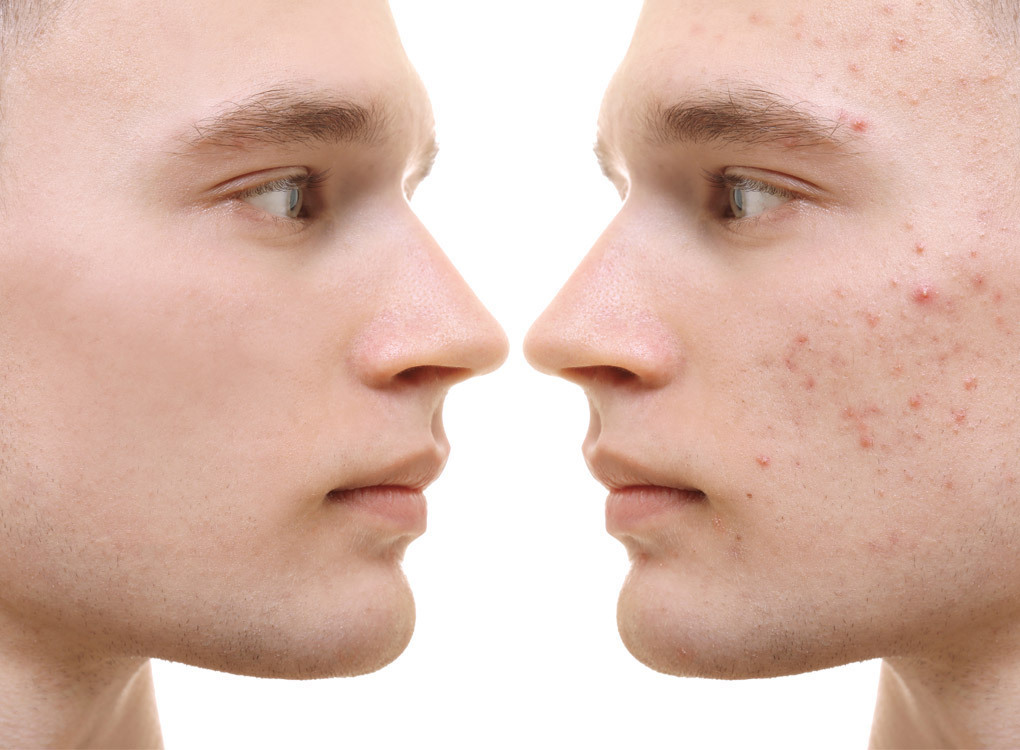Men and Acne: What you need to know

Acne is one of the most common skin issues in the U.S., affecting nearly 60 million Americans –– a quarter of those people are adult men. And while it doesn’t pose any real physical health risks, acne has been linked to reduced self-esteem, anxiety and even depression, which do have health consequences. If you’re feeling challenged by this condition, first, know you’re not alone; second, find comfort in the fact that in most cases, it is very treatable.
Start with why
Male skin is constantly affected by testosterone which can stimulate sebum (oil) production and, lucky us, we tend to have more open pores so they’re more susceptible to accumulating dirt and bacteria. Acne is the result of the skin’s glands getting out of balance, over-producing oil that combines with dry skin cells and outside pollutants to clogs pores. This leads to the visible red bumps and raised pustules that we recognize as acne. Bacteria can also accumulate in pores contributing to acne and triggering inflammation.
Lifestyle factors can also exacerbate troubled skin. Stress, an unhealthy diet or food allergies, hormonal imbalances, medications, genetics or a variety of other factors, including not washing your face properly (if you need a refresher on proper cleansing, keep reading). Your best bet if your acne is severe is to work with a professional aesthetician who can help you identify the root cause, and also take a look at things that are within your control and do your best to clean them up. Limit stress to the best of your ability, make sure you’re eating plenty of antioxidants and clean foods, and go easy on sugar and alcohol.
Create a clean slate
Proper cleansing is the foundation of good skin. I know you know by now that you need to wash your face. However, acne skin needs special care. If you workout or play sports –– particularly ones that involve helmets that can trap sweat near the face –– always make sure you’re giving your skin a good post-workout cleanse.
Now, let’s talk about how we cleanse acne prone skin. It may seem counterintuitive, but what you don’t want to do is strip the skin with harsh cleansers. Keep it simple with a gentle, yet effective cleanser with salicylic and lactic acids to deeply clear pores, provide antibacterial and inflammatory support and kick start exfoliation. Managing bacteria is the first step in healing acne, so never skip a wash and make sure you’re taking the time to work the cleanser in for at least a couple of minutes to give it time to dissolve the dirt and impurities that clog pores and proliferate bacteria.
Turn it over
Increasing exfoliation will help encourage cell turnover so new, healthy cells can emerge. A good choice is gentle scrub that lifts away dead skin cells and contains healing ingredients like our favorite, dragon’s blood, which helps soothe irritation and swelling. Like in the cleansing step, give the product time to do its job. Work the grains into the skin for three to five minutes and then rinse well.
Now I don’t typically encourage taking shortcuts, but in this case you can combine your scrub with your cleanser and knock it out together. However, only exfoliate two to three times per week. Too much scrubbing can start to damage the skin and increase irritation.
Rebuild the foundation
The biggest factor in acne recovery is healing. Acne lesions are cellular wounds and to avoid scarring, they need to be treated. Epidermal growth factors help speed cell renewal and strengthen skin. As new, healthy cells begin to emerge, you’ll start to notice less redness, fewer bumps and over time a smoother, clearer complexion. Protect and support those healthy cells with a zinc-based cream that combats free radical damage.
Serious cases of acne will need assessment and professional treatment, but a good home care routine is essential to preventing further outbreaks and maintaining healthy skin. Just remember the three keys to acne-free skin: control bacteria, increase cell turnover, and support wound healing.
